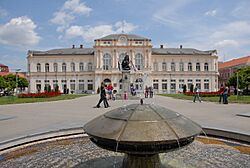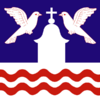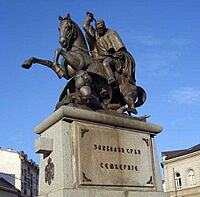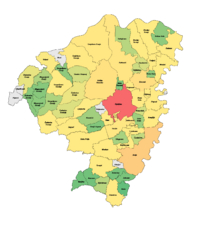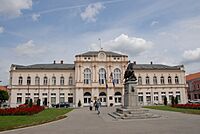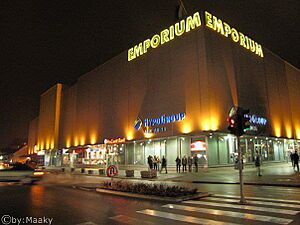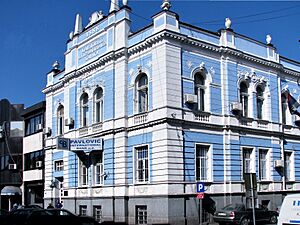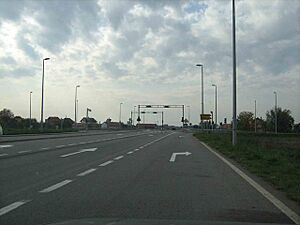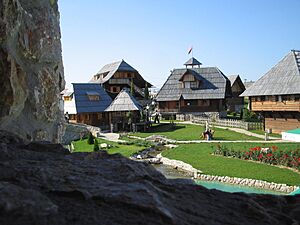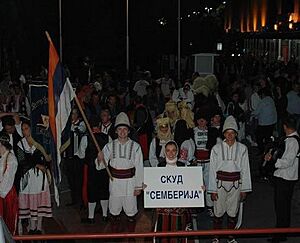Bijeljina facts for kids
Quick facts for kids
Bijeljina
Бијељина (Serbian)
|
||
|---|---|---|
| Grad Bijeljina Град Бијељина City of Bijeljina |
||
|
From top, left to right: The assembly building of Bijeljina, Pavlović bank, the inside of the Church of the Holy Great Martyr George, the outside of the Church of the Holy Great Martyr George, Residential buildings, the Atik mosque, Semberija Museum and the Five Lakes Monastery.
|
||
|
||
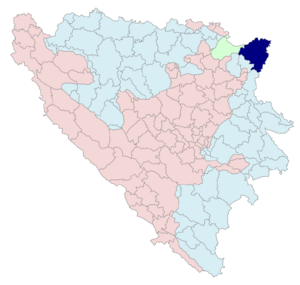
Location of Bijeljina within Republika Srpska
|
||
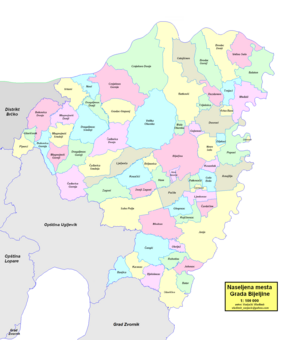 |
||
| Country | ||
| Entity | ||
| Geographical region | Semberija | |
| City status | July 2012 | |
| Area | ||
| • City | 733.85 km2 (283.34 sq mi) | |
| Elevation | 90 m (300 ft) | |
| Population
(2013 census)
|
||
| • City | 107,715 | |
| • Density | 146.7807/km2 (380.160/sq mi) | |
| • Urban | 45,291 | |
| Time zone | UTC+1 (CET) | |
| • Summer (DST) | UTC+2 (CEST) | |
| ZIP Code |
76300
|
|
| Area code(s) | +387 55 | |
Bijeljina (Serbian Cyrillic: Бијељина) is a city and municipality in Republika Srpska, Bosnia and Herzegovina. It is the main city of Semberija, a flat region in the country's northeast. In 2013, about 107,715 people lived there.
Contents
Geography
Bijeljina is in the northeast of Bosnia and Herzegovina. It is bordered by the Sava and Drina rivers. The city also extends over the Majevica mountains. Its total area is 734 square kilometers.
Bijeljina is part of Republika Srpska. It is the center of the Semberija region. Semberija is a flat area with very fertile land. This makes it perfect for farming. Bijeljina is a big center for growing and trading food, especially wheat and vegetables.
Climate
| Climate data for Bijeljina (1991–2020) | |||||||||||||
|---|---|---|---|---|---|---|---|---|---|---|---|---|---|
| Month | Jan | Feb | Mar | Apr | May | Jun | Jul | Aug | Sep | Oct | Nov | Dec | Year |
| Record high °C (°F) | 20.3 (68.5) |
24.0 (75.2) |
27.7 (81.9) |
32.5 (90.5) |
35.0 (95.0) |
37.6 (99.7) |
43.0 (109.4) |
40.7 (105.3) |
38.8 (101.8) |
31.0 (87.8) |
26.4 (79.5) |
22.1 (71.8) |
43.0 (109.4) |
| Mean daily maximum °C (°F) | 5.4 (41.7) |
8.2 (46.8) |
13.6 (56.5) |
19.0 (66.2) |
23.7 (74.7) |
27.5 (81.5) |
29.5 (85.1) |
30.0 (86.0) |
24.5 (76.1) |
19.0 (66.2) |
12.2 (54.0) |
6.0 (42.8) |
18.2 (64.8) |
| Daily mean °C (°F) | 1.2 (34.2) |
3.0 (37.4) |
7.5 (45.5) |
12.5 (54.5) |
17.3 (63.1) |
21.3 (70.3) |
23.0 (73.4) |
22.6 (72.7) |
17.3 (63.1) |
12.2 (54.0) |
7.1 (44.8) |
2.2 (36.0) |
12.3 (54.1) |
| Mean daily minimum °C (°F) | −2.4 (27.7) |
−1.4 (29.5) |
2.1 (35.8) |
6.4 (43.5) |
11.0 (51.8) |
14.9 (58.8) |
16.3 (61.3) |
16.0 (60.8) |
11.6 (52.9) |
7.0 (44.6) |
3.0 (37.4) |
−1.1 (30.0) |
7.0 (44.6) |
| Record low °C (°F) | −23.4 (−10.1) |
−26.6 (−15.9) |
−19.3 (−2.7) |
−6.8 (19.8) |
0.6 (33.1) |
0.0 (32.0) |
8.0 (46.4) |
4.5 (40.1) |
1.0 (33.8) |
−7.5 (18.5) |
−8.2 (17.2) |
−18.7 (−1.7) |
−26.6 (−15.9) |
| Average precipitation mm (inches) | 54.8 (2.16) |
46.0 (1.81) |
55.3 (2.18) |
59.6 (2.35) |
83.2 (3.28) |
87.1 (3.43) |
69.1 (2.72) |
56.9 (2.24) |
62.9 (2.48) |
65.0 (2.56) |
60.2 (2.37) |
58.8 (2.31) |
758.8 (29.87) |
| Average precipitation days (≥ 1.0 mm) | 9.2 | 8.1 | 8.3 | 9.2 | 11.0 | 10.0 | 8.1 | 6.6 | 7.7 | 7.5 | 8.6 | 9.2 | 103.5 |
| Source: NOAA | |||||||||||||
History
Early Times and Ancient History
The first signs of people living in the Bijeljina area are from the New Stone Age (5000–3000 BC). Pottery, tools, and weapons show that the early people of Semberija were connected to other ancient cultures.
Old Slavs and Middle Ages
The oldest historical site from this time is near the Bistrik channel. It has remains of a settlement from the 7th to 12th centuries. An important discovery was a metalworking shop from the 8th century. Here, iron was melted and tools were made.
The oldest religious building, the Tavna Monastery, was built in the Middle Ages. The Bijeljina area became part of the Bosnian state under Stephen Kotromanić. The village of Bistrica was the center of the region back then.
The name Bijeljina was first written down in 1446. The city came under Ottoman rule in 1530. After a big war, it was briefly controlled by Austria. Then, the Ottomans took it back in 1739. Many villages were affected by rebellions against the Ottoman rule.
Austro-Hungarian rule in Bosnia and Herzegovina lasted from 1878 to 1918. The name Bijeljina was used only after 1918, after World War I. Before that, the town was called Bjelina, Belina, or Bilina.
Modern History
In 1838, the first elementary school opened in Bijeljina. A new school building was built in 1902. A famous Serb poet and diplomat, Jovan Dučić, taught there from 1893 to 1895.
In front of the City Hall, there is a statue of King Peter I of Serbia. He ruled the Kingdom of Serbia from 1903 to 1918. The statue was removed during Second World War but was later returned in the early 1990s.
Bosnian War
During the Bosnian War (1992-1995), Bijeljina experienced significant changes. In March 1992, there were clashes in the city. The city came under the control of Serb forces. Many people were displaced from their homes during this time. The village of Batković in the Bijeljina area was a site where people were held during the conflict. After the war, Bijeljina began to rebuild and recover.
Post-war Period
Bijeljina grew a lot after the war, starting in the late 1990s. New homes, roads, schools, and universities were built. The city continued to develop and expand.
The Serb Democratic Party (SDS) led Bijeljina for 28 years. In 2020, a new mayor, Ljubiša Petrović, was elected. He is from the SDS party.
Demographics
Population
| Settlement | 1875 | 1885 | 1895 | 1910 | 1921 | 1931 | 1948 | 1953 | 1961 | 1971 | 1981 | 1991 | 2013 | |
|---|---|---|---|---|---|---|---|---|---|---|---|---|---|---|
| Total | 34,479 | 38,455 | 47,468 | 58,002 | 58,142 | 78,602 | 63,877 | 86,826 | 78,890 | 86,826 | 92,808 | 96,988 | 107,715 | |
| 1 | Amajlije | 1,110 | 1,112 | |||||||||||
| 2 | Balatun | 1,305 | 1,245 | |||||||||||
| 3 | Banjica | 406 | 265 | |||||||||||
| 4 | Batar | 382 | 225 | |||||||||||
| 5 | Batković | 3,483 | 2,515 | |||||||||||
| 6 | Bijeljina | 12,660 | 14,303 | 17,340 | 24,761 | 31,124 | 36,414 | 42,278 | ||||||
| 7 | Bjeloševac | 639 | 442 | |||||||||||
| 8 | Brodac Donji | 735 | 668 | |||||||||||
| 9 | Brodac Gornji | 866 | 767 | |||||||||||
| 10 | Bukovica Donja | 794 | 568 | |||||||||||
| 11 | Bukovica Gornja | 574 | 324 | |||||||||||
| 12 | Čađavica Donja | 1,524 | 577 | |||||||||||
| 13 | Čađavica Gornja | 973 | 676 | |||||||||||
| 14 | Čađavica Srednja | 693 | 533 | |||||||||||
| 15 | Čardačine | 370 | 471 | |||||||||||
| 16 | Čengić | 1,284 | 859 | |||||||||||
| 17 | Ćipirovine | 274 | 622 | |||||||||||
| 18 | Crnjelovo Donje | 2,963 | 2,011 | |||||||||||
| 19 | Crnjelovo Gornje | 1,840 | 1,279 | |||||||||||
| 20 | Dazdarevo | 435 | 522 | |||||||||||
| 21 | Dijelovi | 669 | ||||||||||||
| 22 | Donji Zagoni | 305 | ||||||||||||
| 23 | Dragaljevac Donji | 463 | 339 | |||||||||||
| 24 | Dragaljevac Gornji | 603 | 418 | |||||||||||
| 25 | Dragaljevac Srednji | 1,041 | 741 | |||||||||||
| 26 | Dvorovi | 1,814 | 4,716 | |||||||||||
| 27 | Glavičice | 1,293 | 1,070 | |||||||||||
| 28 | Glogovac | 436 | 402 | |||||||||||
| 29 | Gojsovac | 475 | 683 | |||||||||||
| 30 | Golo Brdo | 198 | 377 | |||||||||||
| 31 | Gradac - Stupanj | 509 | ||||||||||||
| 32 | Hase | 341 | 938 | |||||||||||
| 33 | Janja | 10,458 | 10,542 | |||||||||||
| 34 | Johovac | 338 | 284 | |||||||||||
| 35 | Kacevac | 351 | 268 | |||||||||||
| 36 | Kojčinovac | 794 | ||||||||||||
| 37 | Kovačići | 383 | ||||||||||||
| 38 | Kovanluk | 158 | 508 | |||||||||||
| 39 | Kriva Bara | 255 | 345 | |||||||||||
| 40 | Ljeljenča | 967 | 913 | |||||||||||
| 41 | Ljeskovac | 483 | 969 | |||||||||||
| 42 | Magnojević Donji | 613 | 419 | |||||||||||
| 43 | Magnojević Gornji | 665 | 333 | |||||||||||
| 44 | Magnojević Srednji | 332 | 318 | |||||||||||
| 45 | Mala Obarska | 305 | ||||||||||||
| 46 | Međaši | 896 | 858 | |||||||||||
| 47 | Modran | 1,411 | 963 | |||||||||||
| 48 | Novo Naselje | 1,290 | 832 | |||||||||||
| 49 | Novo Selo | 122 | 1,153 | |||||||||||
| 50 | Ostojićevo | 595 | 440 | |||||||||||
| 51 | Patkovača | 646 | 2,569 | |||||||||||
| 52 | Popovi | 1,134 | 1,238 | |||||||||||
| 53 | Pučile | 769 | 2,090 | |||||||||||
| 54 | Ruhotina | 446 | 276 | |||||||||||
| 55 | Suho Polje | 1,503 | 1,154 | |||||||||||
| 56 | Triješnica | 290 | 496 | |||||||||||
| 57 | Trnjaci | 639 | 1,074 | |||||||||||
| 58 | Velika Obarska | 3,549 | 3,902 | |||||||||||
| 59 | Velino Selo | 451 | 342 | |||||||||||
| 60 | Vršani | 1,249 | 614 | |||||||||||
| 61 | Zagoni | 1,766 | 619 |
Ethnic Composition
| 2013 | 1991 | 1981 | 1971 | |
|---|---|---|---|---|
| Total | 42,278 (100,0%) | 36,414 (100,0%) | 31,124 (100,0%) | 24,761 (100,0%) |
| Serbs | 35,798 (84.67%) | 10,450 (28.70%) | 7,866 (25.27%) | 7,630 (30.81%) |
| Bosniaks | 4,469 (10.57%) | 19,024 (52.24%) | 15,015 (48.24%) | 14,929 (60.29%) |
| Others | 632 (1.495%) | 3,122 (8.574%) | 521 (1.674%) | 349 (1.409%) |
| Unaffiliated | 502 (1.187%) | |||
| Roma | 338 (0.799%) | 976 (3.136%) | 104 (0.420%) | |
| Croats | 315 (0.745%) | 366 (1.005%) | 409 (1.314%) | 677 (2.734%) |
| Yugoslavs | 127 (0.300%) | 3,452 (9.480%) | 6,028 (19.37%) | 637 (2.573%) |
| Unknown | 35 (0.083%) | |||
| Montenegrins | 29 (0.069%) | 60 (0.193%) | 71 (0.287%) | |
| Macedonians | 14 (0.033%) | 64 (0.206%) | 63 (0.254%) | |
| Slovenes | 11 (0.026%) | 17 (0.055%) | 20 (0.081%) | |
| Albanians | 8 (0.019%) | 144 (0.463%) | 237 (0.957%) | |
| Hungarians | 24 (0.077%) | 44 (0.178%) |
| 2013 | 1991 | 1981 | 1971 | |
|---|---|---|---|---|
| Total | 107,715 (100.0%) | 96,988 (100.0%) | 92,808 (100.0%) | 86,826 (100.0%) |
| Serbs | 91,784 (85.21%) | 57,389 (59.17%) | 56,029 (60.37%) | 60,595 (69.79%) |
| Bosniaks | 13,090 (12.15%) | 30,229 (31.17%) | 24,282 (26.16%) | 23,343 (26.88%) |
| Others | 793 (0.736%) | 4,452 (4.590%) | 1,155 (1.245%) | 649 (0.747%) |
| Unaffiliated | 674 (0.626%) | |||
| Croats | 515 (0.478%) | 492 (0.507%) | 500 (0.539%) | 806 (0.928%) |
| Roma | 496 (0.460%) | 1,359 (1.464%) | 168 (0.193%) | |
| Yugoslavs | 151 (0.140%) | 4 426 (4.563%) | 9,090 (9.794%) | 747 (0.860%) |
| Unknown | 102 (0.095%) | |||
| Montenegrins | 36 (0.033%) | 80 (0.086%) | 90 (0.104%) | |
| Macedonians | 33 (0.031%) | 89 (0.096%) | 81 (0.093%) | |
| Slovenes | 22 (0.020%) | 25 (0.027%) | 24 (0.028%) | |
| Albanians | 17 (0.016%) | 164 (0.177%) | 258 (0.297%) | |
| Turks | 1 (0.001%) | |||
| Ukrainians | 1 (0,001%) | |||
| Hungarians | 35 (0,038%) | 65 (0,075%) |
Architecture
The Atik Mosque was built between 1520 and 1566. This was during the time of Sultan Suleiman the Magnificent. It was used for defense in a war and even became a Catholic church for a while. After 1739, it became a mosque again and was rebuilt several times. The mosque was destroyed in 1993 but has since been rebuilt.
The Serbian Orthodox Church of Saint George (Svetog Đorđa) stands where an older church once was. The current building was built in the early 1870s. It mixes Russian and Byzantine styles, with a dome and a tall tower.
The Semberija Museum is in an old building. It has four rooms with exhibits. These exhibits show history from the Stone Age, through Roman times and the Middle Ages, up to the 20th century.
The Basil of Ostrog Monastery is new, built in 2001. It is dedicated to St Basil of Ostrog. Its bell tower is over 30 meters tall and is a symbol of the monastery. The monastery also has a museum, a dining room, and a library. Inside, the temple is decorated with beautiful paintings called frescoes. A special copy of a famous icon, the Trojeručica, is also there. Other churches in Bijeljina include the Holy Temple, the Church of St. Petka, and an old Catholic church.
The Filip Višnjić Library is the oldest cultural place in Bijeljina. It was started in 1932 by important people like Dr. Vojislav Kecmanović. The library has over 120,000 books. It has helped improve culture in the Semberija region.
The Tavna Monastery is in the southern part of Bijeljina. Its exact founding date is unknown. Old writings say it was built by the sons of Stefan Dragutin. He was a Serbian king from 1276 to 1282. The current church is built in the same spot as the first one. Tavna Monastery is older than other monasteries nearby. It was damaged many times over history, including during World War Two. It was rebuilt after the war.
Education
The first primary school in Bijeljina opened in 1938. After World War II, the school system changed. The first elementary school opened in 1951. More elementary schools opened in 1956, 1959, and 1966.
A basic music school has been open in the city since 1953.
Some primary schools in Bijeljina are OŠ Sveti Sava and OŠ Vuk Karadžić. There are also several high schools. These include Filip Višnjić Gymnasium and a music school. There are also agricultural, medical, economic, and technical high schools.
The University of Bijeljina has different departments. These include Law, Economics, Business Economics, and Education. The main private universities are Slobomir P University and University Sinergija.
Economy
Bijeljina has a strong economy. Many people work in different areas. The table below shows how many people were employed in various jobs in 2018.
| Activity | Total |
|---|---|
| Agriculture, forestry and fishing | 336 |
| Mining and quarrying | 25 |
| Manufacturing | 3,706 |
| Electricity, gas, steam and air conditioning supply | 454 |
| Water supply; sewerage, waste management and remediation activities | 450 |
| Construction | 1,129 |
| Wholesale and retail trade, repair of motor vehicles and motorcycles | 5,813 |
| Transportation and storage | 935 |
| Accommodation and food services | 1,096 |
| Information and communication | 551 |
| Financial and insurance activities | 514 |
| Real estate activities | 22 |
| Professional, scientific and technical activities | 809 |
| Administrative and support service activities | 312 |
| Public administration and defense; compulsory social security | 1,836 |
| Education | 1,774 |
| Human health and social work activities | 1,461 |
| Arts, entertainment and recreation | 330 |
| Other service activities | 482 |
| Total | 22,035 |
Transportation
Bijeljina has a good road network. The main roads connect it to other cities like Brcko and Zvornik. There are eleven major roads that lead directly into the city. A bypass road around the city is still being finished.
The main bus station in Bijeljina is in the city center. It is owned by Semberija Transport. From Bijeljina, you can travel by bus to other cities in the region. You can also travel to some cities in Europe, like Ljubljana and Vienna.
Bijeljina has one railway line. This line goes from Bijeljina to Šid in Serbia. From Šid, you can connect to other lines that go to Belgrade or Croatia.
Tourism
Bijeljina hosts an international folklore festival. It is called Semberija folk fest.
The Dvorovi Spa is a famous spa in Republika Srpska. It was created in 1956 when hot thermal water was found. This happened while drilling for oil near Dvorovi village. The water comes from 1350 meters deep and is 75°C hot.
Sports
Bijeljina has a major stadium called Bijeljina City Stadium. It is the home of FK Radnik Bijeljina, a football club. They play in the top football league of Bosnia and Herzegovina. Radnik won the Bosnian Cup in 2016.
OFK Zenit Bijeljina is a newer football club. Their youth teams have won many medals in different countries. Their stadium is called ‘Zenit Arena’. It is close to the city center.
Bijeljina was named the European City of Sport in 2020.
Here are some other sports clubs in Bijeljina:
- Basketball clubs:
- KK Budućnost Bijeljina
- KK Radnik Bijeljina
- KK Fenix Basket Bijeljina
- Volleyball clubs:
- OK Radnik Bijeljina
- OK Libero Bijeljina
- Handball clubs:
- RK Bijeljina
- ZRK Bijeljina
Twin towns – sister cities
Bijeljina is twinned with these cities:
- Azov, Russia
- Brașov, Romania
- Budva, Montenegro
- Goraždevac, Kosovo
- Kosjerić, Serbia
- Kruševac, Serbia
- Kumanovo, North Macedonia
- Langenhagen, Germany
- Leskovac, Serbia
- Ruse, Bulgaria
- Zrenjanin, Serbia
Notable people
- Admir Smajić, footballer, Olympic bronze medalist
- Ana Mirjana Račanović, Miss Bosnia and Herzegovina 2001
- Bego Ćatić, footballer
- Cvijetin Mijatović, Chairman of the Collective Presidency of Yugoslavia, Yugoslav People's Hero
- Darko Todorović, Bosnian footballer
- Duško Kondor, human rights activist, professor of sociology and philosophy
- Filip Višnjić, epic poet
- Frenkie, rapper
- Luka Jović, Serbian footballer
- Mirko Ilić, Serbian graphic designer and comics artist
- Mirza Begić, Slovenian basketball player
- Nevenka Tadić, neuropsychiatrist and mother of former president of Serbia Boris Tadić
- Nihad Hrustanbegovic, composer, accordionist and pianist
- Miloš Bojanić, folk singer
- Rodoljub Čolaković, politician and writer
- Rodoljub Roki Vulović, Bosnian Serb singer, author, performer, former professor, and former school director
- Srđan Vuletić, filmmaker
- Cican Stankovic, Austrian footballer
- Savo Milošević, Serbian footballer, UEFA Euro 2000 Top scorer
- Svetozar Marković (footballer), Serbian footballer
See also
 In Spanish: Bijeljina para niños
In Spanish: Bijeljina para niños


